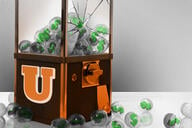You have /5 articles left.
Sign up for a free account or log in.
There must be a newly-minted Ph.D. out there, diss unpublishable, who’d like to write a book for a general audience on the visual rhetoric of wonder cabinets. Please do, so I won’t have to devote the next two years of my life to the subject. All I ask is thanks in the acknowledgments.
Wonder cabinets, or wunderkammern, are those wonderful fetishistic boxes or rooms filled with collected objects from the natural world and human culture. The Times’ review of Lawrence Weschler’s Mr. Wilson’s Cabinet of Wonder says that the wonder cabineteer “seeks to amass all the various kinds of knowledge in the world,” but I wonder if the cabinets aren’t jogs to awareness and challenges to imagination instead: You ever consider the reality of this? (“This” being, for instance, “African stink ants that inhale spores, which turn, fatally, into unicornlike horns….”)
They’re meant to shake us out of our day-to-day lethargy through otherness, maybe even to remind us of mortality in the manner of a Dutch baroque still-life. It’s been said that writing needs to make the familiar unfamiliar, or the unfamiliar familiar, and wonder cabinets also mean to bring difference into the domestic space in service of awareness.
Take a moment to look at wonder cabinet sites linked here by the New York Public Library. Our friends at The World’s Fair have a little summary on the topic too. Come on back when you’re weirded-out.
---
Didn’t take long, did it?
I told actor Crazy Larry a long time ago that when I become rich from blogging I’ll create a Disturbing Room in my mansion, where there’ll be an endless loop of The Beatles’ “Long Long Long” playing, and odd objects and pictures on the walls, from Charlton Heston kissing a gorilla, to a deep-sea diver busking for charity, maybe, since I was a diver myself. Larry says he’d have something called an apocalypse closet, which evidently haunts his dreams, and which I don't want to know any more about.
It’s all in the service of heightening consciousness for our art, but no doubt all our homes and offices have elements of this, from the masks on our walls to the orchids on the windowsills to the souvenir shotglasses from our stop in Lynchburg on the way to see the Chattanooga Choo-Choo. Even our TV sets are banal, electronic wonder cabinets, and this week I was reminded how live theater—a box with five walls, after all, into which we stare—does the same thing.
We’ve taken Starbuck, who’s six, to two “theater” circuses in rapid succession lately. One was the Chinese acrobats troupe, the other Cirque Éloize. Interestingly, the Chinese version was bright and manic—lively, one might say—while the European one was spooky and ghostly, like a dream of death backed with an accordion and clarinet in a minor key. “In the fog you get lost, you find each other, but above all, you are confronted with the unexpected,” the Éloize playbill says.
Starbuck sat wide-eyed but with a child’s deep understanding of the uncanny. I tried to explain a segment to him (“They’re running through the spinning-plate supports as if it were a forest”) but he cut me off. “Got it,” he said. Granted, he asked then if we could get the Black Forest cake at intermission—maybe with a Sierra Mist?—but I know these things are in there now, and working, working on my little writer/artist/poet….


